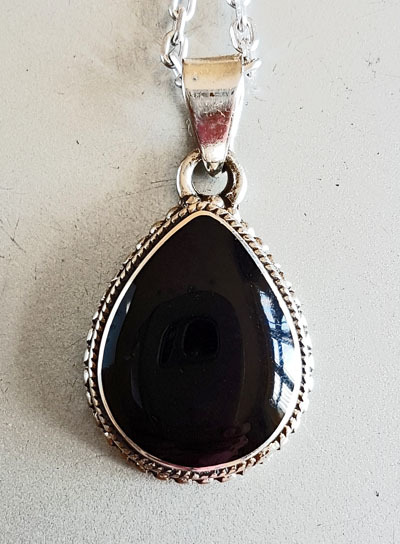 Whitby Jet is a gemstone renowned worldwide for its deep black colour and lustrous shine.
Whitby Jet is a gemstone renowned worldwide for its deep black colour and lustrous shine.
Jet has been used in jewellery, ornaments and charms since the Neolithic era. It was popular in Roman times for its supposed magical and healing properties, and became the height of 19th century fashion when Queen Victoria wore it in her mourning for Prince Albert.
So what is jet, and why is it so strongly associated with this seaside town on the North Yorkshire coast? This EarthCache explores the geology of jet, with waypoints to visit along the way to bring this story to life.
How jet was formed - raw material
Stage One Start at the EarthCache coordinates - the Jurassic Walk in Pannett Park. Check the information board and follow the path to gain a feel for some of the plants that grew in the Jurassic era.
Whitby Museum at the top of the park has a great jet collection - you are not required to visit the museum for this EarthCache, but if you are interested then please check its website for opening times and entry fees.
Note: Since setting this stage, I have unfortunately discovered that dogs (other than guide dogs) are not allowed in the park. If this deters you from visiting the park, please note that you can clearly identify the tree behind the information board from the pavement outside the park only a few metres away - sorry for this inconvenience.
Jet is a type of lignite, a fossilised organic material formed from wood.
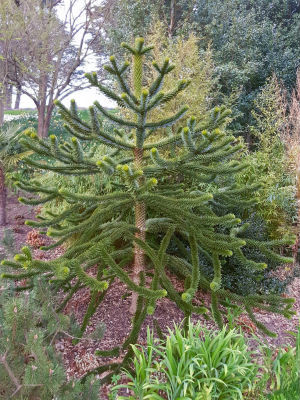
The jet found in North Yorkshire dates from some 180 million years ago - the Toarcian age in the early Jurassic period. At that time the land was covered in an abundance of plant life, including Araucaria trees growing to 30-40m in height. The tree behind the information board is the closest living relative to those trees, albeit much smaller than those ancient giants.
When the trees died, some of them fell into rivers or were washed into them by storms and floods. As they floated downstream the trunks were battered and stripped of their branches and then washed out to sea.
The trunks became waterlogged in this warm, shallow sea and then sank and settled into its soft, dark muddy bed. The anoxic conditions on the sea floor prevented the wood from rotting, and so it slowly became buried by the mud, clay and dead matter settling over it.
This warm sea existed where you are now standing. In the Jurassic period, the land that is now the North York Moors was located roughly where the Mediterranean Sea lies today and was below sea level in what is called the Cumberland Basin. The dead trees that ended up in it would have grown on higher land off to the North West.
How jet was formed - geological forces
Stage Two Head downhill into town and the harbour area. Ideally 'out to sea' onto a pier, although access is sometimes restricted for maintenance, so anywhere in the harbour area that gives views of both cliffs. Face back to land for a clear view of the East Cliff to your left and West Cliff to your right.
Over millions of years, those tree trunks lying in the mix of mud and clay, plant and sealife debris were compressed by the intense weight of further layers settling above them and the seawater above that, and were heated from the earth's core below. The wood was crushed flat, absorbing oils and minerals from the material around it, becoming fossilised into small pieces and occasionally short, thin seams of jet. This jet was scattered randomly in the sedimentary mudstone layers forming around it.
The mudstone rock formed at this period in this area is called the Whitby Mudstone Formation or Upper Lias Clay. It is a medium to dark grey mudstone, rich in fossils and with some highly bituminous layers. It formed in a series of 'members' that are exposed at different locations along the North Yorkshire coastline. Here at Whitby, the bottom 12m of the East Cliff is part of the Alum Shale member. Above that on the East Cliff, and for all the visible part of the West Cliff, you see later layers of mostly sandstones. Take a look at the two cliffs to observe the differences between these rock formations. Looking at the height and mass of the cliffs, you can imagine the sheer pressure bearing down on those fallen tree remains.
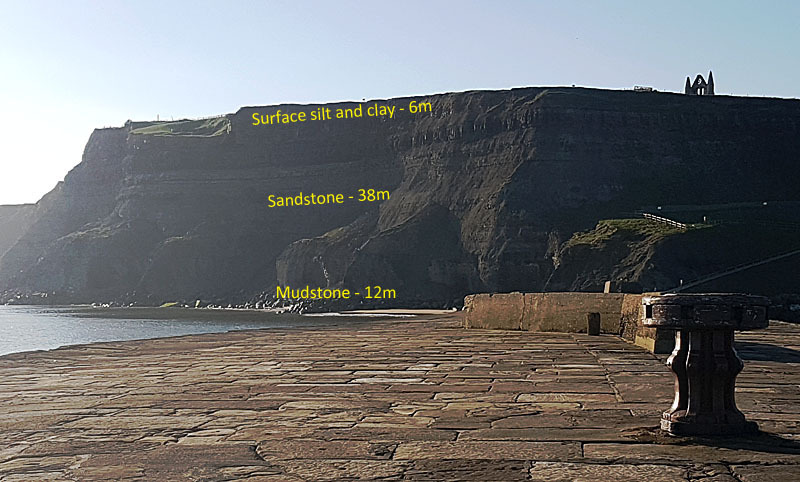
The Jet Rock layer of this mudstone, where the finest quality hard jet is found, is in the Mulgrave Shale member which is below sea level here at Whitby, but can be seen further along the coast in both directions (for example on the far side of Sandsend and at Kettleness) and is near enough to the surface at various sites inland across the moors to have been mined in Victorian times to meet demand.
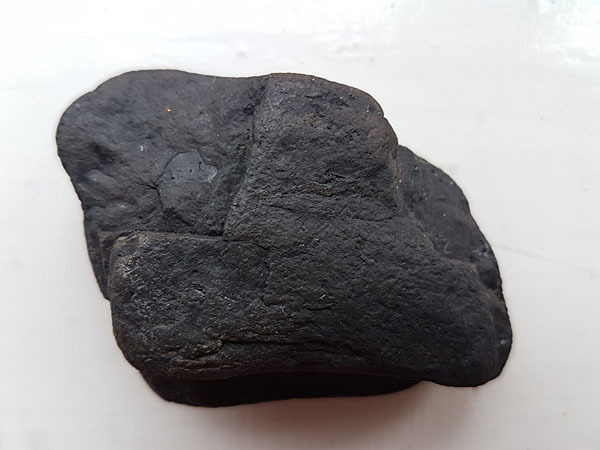 Once jet has formed, it is a matt black material (until polished) buried in small pieces in the finely laminated layers of the surrounding mudstone, sometimes with impressions of fossilised sea creatures visible on its surface. Under a microscope you can still see signs of its original tree structure.
Once jet has formed, it is a matt black material (until polished) buried in small pieces in the finely laminated layers of the surrounding mudstone, sometimes with impressions of fossilised sea creatures visible on its surface. Under a microscope you can still see signs of its original tree structure.
The commonest way to find it - though it'll take some time and you'll need to be in luck! - is as a sample piece lying on the rocky shoreline, in amongst all the other rocks, broken free from the Jet Rock layer and washed up on shore by the powerful destructive force of the sea tides.
Refer to The Haggerlythe at Whitby EarthCache for more details of this coastal erosion process.
At low tide, it is possible to approach both cliffs for closer observation if you wish - but you are not required to do so to complete this EarthCache. You are generally safe stood on the beach looking up at the West Cliff sandstone, but if you decide to view the mudstone along the East Cliff base then please take extreme care - rock falls are common, the floor can be very slippery and the tide comes in fast. Always check the tide times to ensure that you only go out when it's a falling tide, wear suitable protective head gear and do not get up too close to or in any way disturb this fragile rock face.
How jet was formed - finished material
Stage Three Head back into town to Church Street, where you will find many jet retailers with extensive displays of jet jewellery and ornaments. Look carefully and you will find stores with displays of original pieces of jet and demonstrations of how it is worked. Many of the small cottages you have passed, and that you can see down the narrow alleys along this street, would have been jet workshops back in Victorian times.
The finest jet, known as hard jet, is formed in anoxic conditions in saltwater, whereas "soft" jet forms in freshwater. As the name implies, hard jet is less brittle when worked on, polishes to a deeper shine and is harder wearing in use when compared to soft jet. It is therefore seen as the best quality jet, and so the most desirable and valuable. Any reputable supplier will only deal in hard jet, which makes long lasting and quality jewellery; anything made from soft jet is likely to disappoint in the long run, being more prone to scratching and even fracturing when exposed to significant heat or pressure.

Looking at the shop displays, you can see the many creative ways that jet can be worked and the wide variety of end products that are sold. You can also see its dark, lustrous shine after it has been fully polished.
If you get to handle jet, you will discover that like some other organic gemstones it is surprisingly light and warm to the touch, making even the largest ornamental pieces comfortable to wear. In spite of its hard shiny appearance, it is in fact not that tough a gemstone, only measuring 3-4 on the Mohs scale.
Finally, however magical it may be to look at, jet probably doesn't possess all the properties ascribed to it in earlier times, such as here by Pliny the Elder:
The fumes of it, burnt, keep serpents at a distance, and dispel hysterical affections: they detect also a tendency to epilepsy, and act as a test of virginity. A decoction of this stone in wine is a curative of toothache; and in combination with wax, it is good for scrofula."
EarthCache questions
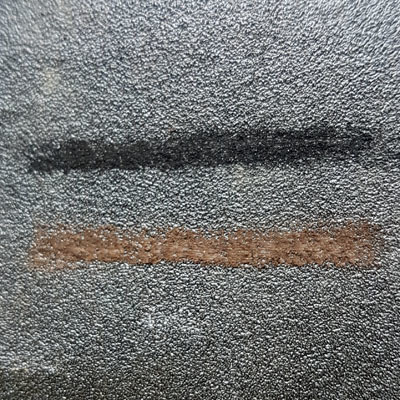 Please consider the following questions and send me your answers by email or message through the website.
Please consider the following questions and send me your answers by email or message through the website.
- What is the common name of the modern tree related to the trees from which jet is formed?
- Describe any differences you noticed between the mudstone at the base of East Cliff and the sandstone of West Cliff.
- There is a simple test of any black rocky material that you find on the beach to see if it might be jet. What colour streak does jet leave when scraped on an abrasive surface?
- Name another organic gemstone.
You are then free to log your find of the EarthCache, without waiting for my reply. But I do check all answers, and will respond to your message.